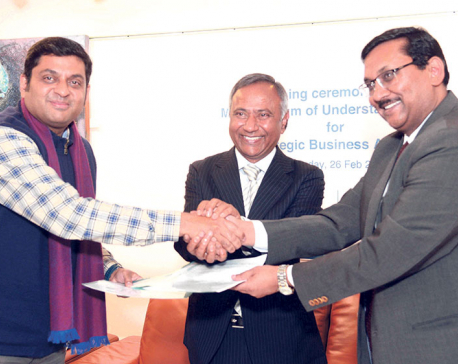
OR
#Opinion
Nepal's Development Aspirations and the Road to Net-Zero Emissions by 2045
Published On: September 10, 2023 10:00 AM NPT By: Subash Pandey


Subash Pandey
The author is currently working as an International Climate Action Intern with World Resources Institute based in Washington DC. He is a graduate student of Climate Science and Policy at Bard College in New York.news@myrepublica.com
Nepal's pursuit of sustainable development and its commitment to achieving net-zero emissions by 2045 represent a complex interplay of socio-economic ambition and environmental responsibility. The Fifteenth Five-year Development Plan and the Vision 2043 proposed under this plan underscores the nation's determination to transition from a developing to a developed country, all while addressing the urgent need for emissions reduction. This article critically examines this intersection, unpacking the challenges, trade-offs, and synergies that mark Nepal's dual mandate of becoming a developed country and achieving a net-zero status by 2045.
The Fifteenth Five-year Development Plan, adopted in 2018/19, articulates Nepal's aspiration to elevate its status to a high-income country by 2043. The overarching goal of the Vision 2043 is even more ambitious – to transform Nepal into a developed nation. However, amidst these aspirations, the pressing issue of net-zero emissions by 2045 has emerged as a paramount concern, compelling the nation to confront the intricate dynamics of sustainable development in the face of environmental stewardship.
Central to Nepal's development narrative is the strategic funneling of resources into key infrastructure sectors, including transportation, hydropower, irrigation, and communication. Bolstered by a list of "projects of National Pride," such as the Njghadh International Airport and the extensive 1,003 km East-West Electric Railway line, Nepal's projected developmental trajectory is ambitious. Yet, the realization of these infrastructural dreams must harmonize with ambitious emission reduction goals, demonstrating the nation's commitment to combating climate change.
Intricately linked to this ambitious vision is the delicate equilibrium between economic growth and environmental conservation. This challenge is more complex than mere rhetoric, resonating with the tangible limitations posed by technological capacities, institutional frameworks, and the absence of a comprehensive implementation plan of proposed policies. Negotiating this complex landscape poses an arduous task, as short-term trade-offs between economic expansion and ecological preservation, potentially hindering Nepal's transition to a low-carbon, resilient economy.
Empirical findings demonstrate Nepal's potential to achieve economic growth without increasing greenhouse gas emissions. Nevertheless, the prospect of achieving both a developed status by 2043 and net-zero emissions by 2045 requires a development of detailed-strategies. These detailed strategies must include a clear carbon tax framework, effective carbon capture and storage methodologies, and a resolute commitment to preserving the existing forest coverage, which currently envelopes 45% of Nepal's land area.
The foundation for Nepal's net-zero commitment rests on the natural assets at its disposal. Notable among these is the commendable progress made through community forestry initiatives, which have led to a remarkable increase in forest coverage from 26% in 1992 to 45% in 2016. However, this achievement is accompanied by a parallel economic cost, evidenced by Nepal's annual expenditure of approximately $129 million on timber and furniture imports. The imperative now lies in transitioning from a predominantly conservation-oriented approach to sustainable management, where an emphasis on regeneration and resource utilization coalesce, fostering both economic prosperity and ecological vitality.
In parallel, hydropower assumes a central role in Nepal's development trajectory and net-zero ambitions. Anchored in the vast potential of Himalayan river systems, hydropower projects emerge as a pivotal driver towards net-zero emissions. However, the projected climate change in the Himalayas paints a bleak picture in achieving hydropower potentials. While the immediate effects of glacier melt may augment energy generation, the sustainability of this energy narrative hinges on diversifying energy sources to encompass solar and wind energy. This strategic shift is crucial to mitigate the vulnerability of hydropower generation resulting from the eventual depletion of glacial reservoirs.
Furthermore, Nepal's steadfast pursuit of these ambitions has not been without challenges. A discrepancy between policy formulation and implementation becomes evident when examining the realm of climate action. The volatile nature of tax policies concerning electric vehicles, for instance, illustrates the instability that hampers the harmonization of climate aspirations with developmental goals. This discord underscores the imperative of a cohesive policy framework that resonates with both long-term climate objectives and the needs of sustainable development.
In the realm of climate policy, Nepal's journey towards net-zero emissions encounters additional complexities. While a conceptual vision for achieving net-zero emissions exists, the tangible pathways to realization remain elusive. The absence of a comprehensive financing strategy raises pertinent questions about the feasibility of translating intentions into tangible actions. Moreover, delays in endorsing the Nationally Determined Contributions (NDC) implementation plan from the Cabinet and the imminent revision of the NDC by 2025 introduce a layer of uncertainty, muddling the trajectory of Nepal's net-zero endeavors.
The Vision 2043 carries an ambitious agenda, aiming to advance Nepal's economic prospects while ensuring environmental preservation. However, a noticeable void exists in the strategy, as it fails to articulate a concrete roadmap for achieving rapid economic growth without compromising the environment's health.
The strategy's emphasis on achieving net-zero emissions by 2045 is commendable, yet the document's narrative is somewhat incomplete. While it discusses various emissions scenarios, it overlooks a crucial aspect: the explicit pathways that will lead to Nepal's attainment of both developed country status by 2043 and the ambitious net-zero emissions goal by 2045.
This gap in the strategy's detailing raises an important question: Why does Nepal aspire to reach net-zero emissions by 2045, a goal ahead of other nations with more advanced economies and resources? Countries like China, with a net-zero target of 2060, and India, aiming for 2070, have set their sights on later dates, allowing more time for technological advancements and policy implementations.
This arbitrary timeline to achieve net-zero status undermines credibility of Nepal’s proposed climate actions and underscores the need for a more thorough examination of Nepal's proposed climate strategy. Delving into the rationale behind the 2045 net-zero goal and comparing it to the strategies of countries in similar developmental stages or those ahead in various aspects can provide valuable insights. This evaluation can shed light on the feasibility and effectiveness of Nepal's aspirations, offering a clearer perspective on the nation's commitments in the context of global efforts towards sustainability and climate action.
You May Like This

Nepal online trade: Decorating Nepal
Nepal Online Trade is a business initiative of Sajak Yonjan that sells décor materials imported from China, Hong Kong, and... Read More...

Govt should prioritize Miss Nepal: Miss Nepal Shrinkhala Khatiwada
MAKWANPUR, April 24: Newly crowned Miss Nepal World 2018, Shrinkhala Khatiwada has urged the government to prioritize the pageant as... Read More...

Standard Chartered Bank Nepal, Nepal Mediciti join hands
KATHMANDU, Mar 1: Standard Chartered Bank Nepal Ltd (SCBNL) and Nepal Mediciti have signed an agreement to provide various discounted... Read More...




Just In
- Sunkoshi-Marin Diversion Project’s tunnel construction nears completion, breakthrough scheduled for May 8
- Govt tightens security arrangement for Third Investment Summit 2024
- Pesticide residue found in vegetables in Nepalgunj
- Aam Janata Party and Samajwadi Jana Ekata Party merge
- 1,600 participants confirmed for Nepal Investment Summit
- Ilam-2 by-elections held peacefully, vote count likely to start tonight
- NEA schedules five-day power cut across Kathmandu Valley for underground cable installation
- Hundreds of passengers including foreign tourists in distress as poor visibility halts flights to and from PRIA







-1200x560-wm_20240427144118.jpg)





Leave A Comment